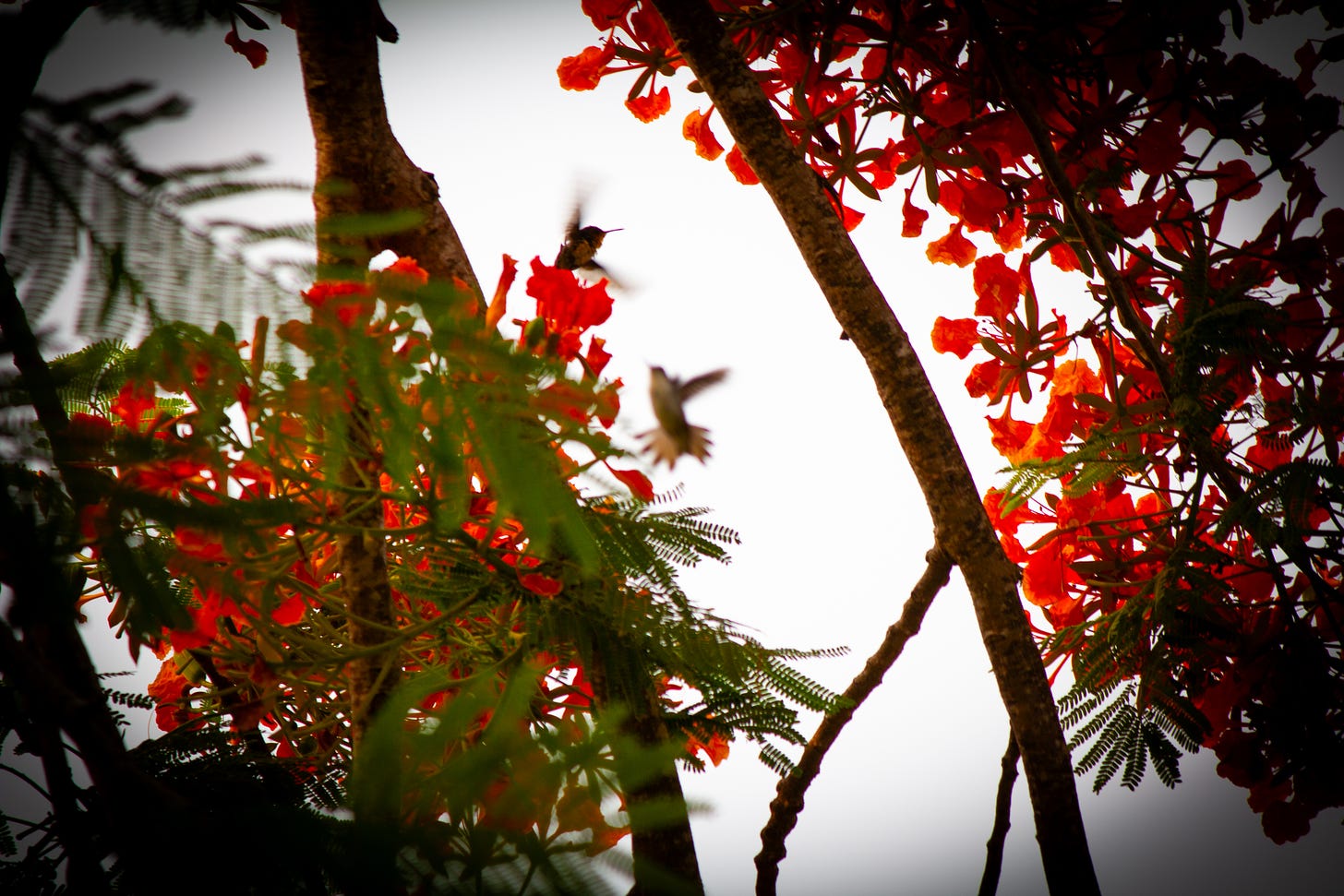The tree was dipped in orange gold and stood defiant, staring out across the Caribbean Sea. The rare breeze—when it deigned to make an appearance at all—insisted that the fiery flowers sway and dance, and so the tree came alive at the bottom of the hill, a watchful beacon atop a rocky coast.
I stood beneath that tree each morning—three mornings in a row in Punta Gorda, Belize—hot, sweaty and enchanted. Several feet beneath me, waves tickled the stony shore in crashing laughter. The town had not yet come alive, the children had not yet stumbled down the hill and off to school, and the dog at rest where the road split had not yet woken up—if the thing was still alive at all.
I stood beneath that tree, listening. It didn’t take long before I realized the tree was humming—a constant tune, a sound to lure wayward ships and sleepwalking visitors. Hum hum hummmmm flitter.
Because then—standing still and watchful, attentive—it became clear: the tree was host to hummingbirds. Dozens of them. They became obvious as soon as you stopped to look—and only then. Shots of glimmering green, flittering wings and pointed silhouettes. Stare long enough at a cluster of fire flowers and a hummingbird would appear. But try to take in the whole tree, and the winged critters fell into shadow. They would be seen as themselves or not at all.
On the first day, I listened to the hum. On the second day, I brought my camera. On the third day, I called it ritual.
What I learned on day two was that hummingbirds are quick. If you spy one sitting on a branch, the photo is easy—but uneventful. A shadow in the shape of a beaky bird. Level two is harder. If you coax your camera to focus—insist on it, in fact—you catch the bird at work. Rapid wings refusing surrender, the thing hovering atop a flower just there, just over there. Amazing.
But a third option presented itself.
There were moments when two hummingbirds collided, two pairs of fluttering wings entangled in anger or love or something more, a helicopter plummeting to the steaming stone below, out of control. These birds never went up, only down, a wreck of a connection, twirling, swirling, crashing. The hum got louder, and even the tree seemed to back away as these two enmeshed creatures had their way, battled it out. And then, at the last moment, when wave and rock seemed inevitable, they split, buzzing again ever upward. And the orange tree laughed as the sea tickled the stone.
I wonder what those hummingbirds have to teach us. Sit alone atop a branch in stillness and solitude and safety. Hover about a flaming orange flower, sipping at sweetness. But collide into the life of another and spiral out of control, downward and devastating and necessary. It isn’t safe and sure, but it’s what brings those birds together, humming. It’s the how of life.
And I wonder if that’s not what we’re all called to do. I wonder if that’s not what we do already, necessarily so. And I wonder if we hear the laughter of the tree as it delights in our brush with wave and rock and heat.
And another thing:
My gratitude to
who interviewed me for a piece over at Word on Fire about my book, “My Life with the Jedi: The Spirituality of Star Wars.” Check it out!Last week’s “Now Discern This” was all about using the examen to jumpstart the summer. Give it a go.





You are a very good writer, and I read your column ( NOW DISCERN THIS ) every week. One word usage I do not like is the current use of the word ‘thing’ for an animate being, part of God’s ongoing creation. … “if the thing was still alive…”
Loved this.